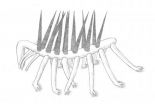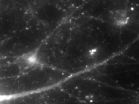(Press-News.org) The electronics we use for our computers only knows two different states: zero or one. Quantum systems on the other hand can be in different states at once, they can store a superposition of "zero" and "one". This phenomenon could be used to build ultrafast quantum computers, but there are several technological obstacles that have to be overcome first. The biggest problem is that quantum states are quickly destroyed due to interactions with the environment. At TU Wien (Vienna), scientists have now succeeded in using a protection effect to enhance the stability of a particularly promising quantum system.
A Quantum Computer Made of Two Systems
There are various concepts for possible quantum computers. "What we use is a hybrid system of two completely different quantum technologies", says Johannes Majer. Together with his team, he couples microwaves and atoms, investigating and building a new type of quantum memory. The theorists Dmitry Krimer and Stefan Rotter developed a theoretical model describing the complex dynamics in such hybrid quantum systems.
In a microwave resonator, photons are created. They interact with the spin of nitrogen atoms, which are built into a diamond. The microwave resonator can be used to quickly transport quantum information. The atomic spins in the diamond can store it – at least for a period of several hundred nanoseconds, which is long compared to the time scale on which photons move in the microwave resonator.
"All nitrogen atoms are completely identical. But when they are placed in slightly different surroundings, they have slightly different transition frequencies", says Stefan Putz, PhD-student at Vienna University of Technology. The atomic spins behave like a room full of pendulum clocks. Initially they may oscillate in sync, but as they can never be precisely identical, they eventually lose their rhythm, creating random noise.
Coupling Causes Order
"By creating a strong coupling between the atomic spins and the resonator, it is possible to dramatically prolong the time during which the spins oscillate in strict time – if their energy levels obey the right distribution", says Dmitry Krimer. The atomic spins do not directly interact with each other, but the mere fact that they are collectively coupled to the microwave resonator prevents them from changing into a state in which they cannot be used for processing quantum information any longer. This protection effect considerably enhances the duration in which quantum information can be read out from the atomic spins.
"Improving the quantum coherence time with this cavity protection effect opens up many promising applications for our hybrid quantum system", says Johannes Majer.
The paper has now been published in Nature Physics.
INFORMATION:
Further information
Dr. Johannes Majer
Institute for Atomic and Subatomic Physics
TU Wien
Stadionallee 2, 1020 Wien
T: +43-1-58801-141838
johannes.majer@tuwien.ac.at
'Cavity protection effect' helps to conserve quantum information
Coupling atomic spins in diamonds to microwave resonators could lead to new quantum technologies. Researchers at the Vienna University of Technology (TU Wien) have now managed to dramatically prolong the time these systems can store information
2014-08-17
ELSE PRESS RELEASES FROM THIS DATE:
FDA-approved drug restores hair in patients with Alopecia Areata
2014-08-17
NEW YORK, NY (August 17, 2014) —Researchers at Columbia University Medical Center (CUMC) have identified the immune cells responsible for destroying hair follicles in people with alopecia areata, a common autoimmune disease that causes hair loss, and have tested an FDA-approved drug that eliminated these immune cells and restored hair growth in a small number of patients.
The results appear in today's online issue of Nature Medicine.
In the paper, the researchers report initial results from an ongoing clinical trial of the drug, which has produced complete hair regrowth ...
Fascinating rhythm: Light pulses illuminate a rare black hole
2014-08-17
The universe has so many black holes that it's impossible to count them all. There may be 100 million of these intriguing astral objects in our galaxy alone. Nearly all black holes fall into one of two classes: big, and colossal. Astronomers know that black holes ranging from about 10 times to 100 times the mass of our sun are the remnants of dying stars, and that supermassive black holes, more than a million times the mass of the sun, inhabit the centers of most galaxies.
But scattered across the universe like oases in a desert are a few apparent black holes of a more ...
A shift in the code: New method reveals hidden genetic landscape
2014-08-17
Cold Spring Harbor, NY – With three billion letters in the human genome, it seems hard to believe that adding a DNA base here or removing a DNA base there could have much of an effect on our health. In fact, such insertions and deletions can dramatically alter biological function, leading to diseases from autism to cancer. Still, it is has been difficult to detect these mutations. Now, a team of scientists at Cold Spring Harbor Laboratory (CSHL) has devised a new way to analyze genome sequences that pinpoints so-called insertion and deletion mutations (known as "indels") ...
New home for an 'evolutionary misfit'
2014-08-17
One of the most bizarre-looking fossils ever found - a worm-like creature with legs, spikes and a head difficult to distinguish from its tail – has found its place in the evolutionary Tree of Life, definitively linking it with a group of modern animals for the first time.
The animal, known as Hallucigenia due to its otherworldly appearance, had been considered an 'evolutionary misfit' as it was not clear how it related to modern animal groups. Researchers from the University of Cambridge have discovered an important link with modern velvet worms, also known as onychophorans, ...
Stem cells reveal how illness-linked genetic variation affects neurons
2014-08-17
VIDEO:
Human neurons firing
Click here for more information.
A genetic variation linked to schizophrenia, bipolar disorder and severe depression wreaks havoc on connections among neurons in the developing brain, a team of researchers reports. The study, led by Guo-li Ming, M.D., Ph.D., and Hongjun Song, Ph.D., of the Johns Hopkins University School of Medicine and described online Aug. 17 in the journal Nature, used stem cells generated from people with and without mental illness ...
New Stanford research sheds light on how children's brains memorize facts
2014-08-17
As children learn basic arithmetic, they gradually switch from solving problems by counting on their fingers to pulling facts from memory. The shift comes more easily for some kids than for others, but no one knows why.
Now, new brain-imaging research gives the first evidence drawn from a longitudinal study to explain how the brain reorganizes itself as children learn math facts. A precisely orchestrated group of brain changes, many involving the memory center known as the hippocampus, are essential to the transformation, according to a study from the Stanford University ...
Suspect gene corrupts neural connections
2014-08-17
Researchers have long suspected that major mental disorders are genetically-rooted diseases of synapses – the connections between neurons. Now, investigators supported in part by the National Institutes of Health have demonstrated in patients' cells how a rare mutation in a suspect gene disrupts the turning on and off of dozens of other genes underlying these connections.
"Our results illustrate how genetic risk, abnormal brain development and synapse dysfunction can corrupt brain circuitry at the cellular level in complex psychiatric disorders," explained Hongjun Song, ...
Stuck in neutral: Brain defect traps schizophrenics in twilight zone
2014-08-17
People with schizophrenia struggle to turn goals into actions because brain structures governing desire and emotion are less active and fail to pass goal-directed messages to cortical regions affecting human decision-making, new research reveals.
Published in Biological Psychiatry, the finding by a University of Sydney research team is the first to illustrate the inability to initiate goal-directed behaviour common in people with schizophrenia.
The finding may explain why people with schizophrenia have difficulty achieving real-world goals such as making friends, completing ...
Virginity pledges for men can lead to sexual confusion -- even after the wedding day
2014-08-17
Bragging of sexual conquests, suggestive jokes and innuendo, and sexual one-upmanship can all be a part of demonstrating one's manhood, especially for young men eager to exert their masculinity.
But how does masculinity manifest itself among young men who have pledged sexual abstinence before marriage? How do they handle sexual temptation, and what sorts of challenges crop up once they're married?
"Sexual purity and pledging abstinence are most commonly thought of as feminine, something girls and young women promise before marriage," said Sarah Diefendorf, a sociology ...
Study finds range of skills students taught in school linked to race and class size
2014-08-17
SAN FRANCISCO -- Pressure to meet national education standards may be the reason states with significant populations of African-American students and those with larger class sizes often require children to learn fewer skills, finds a University of Kansas researcher.
"The skills students are expected to learn in schools are not necessarily universal," said Argun Saatcioglu, a KU associate professor of education and courtesy professor of sociology.
In effort to increase their test scores and, therefore, avoid the negative consequences of failing to meet the federal standards ...
LAST 30 PRESS RELEASES:
Heart-brain connection: international study reveals the role of the vagus nerve in keeping the heart young
Researchers identify Rb1 as a predictive biomarker for a new therapeutic strategy in some breast cancers
Survey reveals ethical gaps slowing AI adoption in pediatric surgery
Stimulant ADHD medications work differently than thought
AI overestimates how smart people are, according to HSE economists
HSE researchers create genome-wide map of quadruplexes
Scientists boost cell "powerhouses" to burn more calories
Automatic label checking: The missing step in making reliable medical AI
Low daily alcohol intake linked to 50% heightened mouth cancer risk in India
American Meteorological Society announces Rick Spinrad as 2026 President-Elect
Biomass-based carbon capture spotlighted in newly released global climate webinar recording
Illuminating invisible nano pollutants: advanced bioimaging tracks the full journey of emerging nanoscale contaminants in living systems
How does age affect recovery from spinal cord injury?
Novel AI tool offers prognosis for patients with head and neck cancer
Fathers’ microplastic exposure tied to their children’s metabolic problems
Research validates laboratory model for studying high-grade serous ovarian cancer
SIR 2026 delivers transformative breakthroughs in minimally invasive medicine to improve patient care
Stem Cell Reports most downloaded papers of 2025 highlight the breadth and impact of stem cell research
Oxford-led study estimates NHS spends around 3% of its primary and secondary care budget on the health impacts of heat and cold in England
A researcher’s long quest leads to a smart composite breakthrough
Urban wild bees act as “microbial sensors” of city health.
New study finds where you live affects recovery after a hip fracture
Forecasting the impact of fully automated vehicle adoption on US road traffic injuries
Alcohol-related hospitalizations from 2016 to 2022
Semaglutide and hospitalizations in patients with obesity and established cardiovascular disease
Researchers ‘listen in’ to embryo-mother interactions during implantation using a culture system replicating the womb lining
How changing your diet could help save the world
How to make AI truly scalable and reliable for real-time traffic assignment?
Beyond fragmented markets: A new framework for efficient and stable ride-pooling
Can shape priors make road perception more reliable for autonomous driving?
[Press-News.org] 'Cavity protection effect' helps to conserve quantum informationCoupling atomic spins in diamonds to microwave resonators could lead to new quantum technologies. Researchers at the Vienna University of Technology (TU Wien) have now managed to dramatically prolong the time these systems can store information







